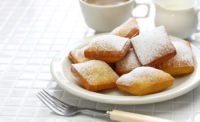While overall growth is minimal, classic pretzel products are clearly alive and well in today’s snack foods market.
Overview | Chips | Puffed/Extruded Snacks | Popcorn | Snack Mixes & Nuts | Tortilla Chips | Pretzels | Frozen Snacks | Crackers
But over the past decade, these traditional sticks, nuggets, rods and twists have seen a highly diversified range of products enter the fray. While chocolate-covered, candy-like pretzel indulgences and better-for-you, sprouted-grain pretzels attract interest at opposite ends of the spectrum, traditional products have stayed the course, still accounting for the lion’s share of sales in this classic segment of salty snacks.
But that’s not to say that pretzels don’t still have a trick or two up their sleeve.
Market data
The pretzels segment of salty snacks remained flat overall for the 52 weeks ending April 17, per IRI, Chicago, dipping 0.84 percent in dollar sales to $1.2 billion.
That said, two companies clearly stood out for the year in terms of top dollar sales growth: Unique Pretzel Bakery and Herr Foods. Unique Pretzel Bakery—the 2016 Snack Food & Wholesale Bakery “Snack Producer of the Year”—was the growth leader in the segment, up 14.50 percent in dollar sales to 11.5 million, per IRI, largely based on sales of its Original Splits products, which were up 35.54 percent to $6.7 million. Herr Foods saw its pretzel business grow by 11.30 percent in dollar sales to $22.8 million.
Frozen pretzels also took a dip, down 2.49 percent in dollar sales for the year, per IRI, to $74.5 million. J&J Snack Foods Corp. still leads the segment by a wide margin, but was likewise down a bit, slipping 2.57 percent to $54.2 million. Cole’s Quality Foods saw a nice jump for its Pretzel Sticks, which are stuffed with pub cheese—up 279.06 percent to $3.7 million. Auntie Annie’s also saw strong growth for its frozen soft pretzels, up 94.30 percent to $5.3 million.
Tonya’s Gluten Free Kitchen specializes in gluten-free frozen soft pretzels, and while its distribution is still highly concentrated in the Northeast, sales have tracked forward, up 33.18 percent over the past year to $251,479. Organic is also seeing niche demand. Rudi’s Organic Bakery expanded into frozen soft pretzels in 2013 and saw sales pick up over the past year, up 235.09 to $52,939.
Back in shelf-stable, select snack producers are finding resonance with the combination of chocolate and pretzels. The chocolate-covered salted snack segment within “miscellaneous snacks” grew by 11.48 percent in dollar sales to $179.0 million for the 52-week period. One clear success story centers on the Snappers line from Edward Marc Brands/The Milk Shake Factory, which grew by 505.15 percent in dollar sales for the year, taking in $8.7 million.
Looking back
The core lineup of traditional pretzels—consisting of Snyder’s-Lance brand Snyder’s of Hanover ($409.2 million in sales), private label ($208.9 million) and PepsiCo/Frito-Lay brand Rold Gold ($177.1 million)—accounts for the vast majority of sales in the segment. At the brand level, Snyder’s of Hanover dropped by 4.51 percent in dollar sales per IRI, and Rold Gold slipped by 6.59 percent. Of the top three, only private label saw a gain, up 2.17 percent. One bright spot for Snyder’s-Lance was its Snyder’s of Hanover 100 Calorie Pack Pretzels, which were up 6.42 percent in dollar sales to $19.3 million.
Outside of the core, much of the incremental growth we are seeing in the pretzels segment results from strategic product diversification.
Herr Foods recently launched a Pub Style Thins Sourdough product. The company also offers Bite Size and San Francisco Specials varieties of its sourdough pretzels. The latter line was up 13.31 percent in dollar sales for the year to $3.7 million.
J&J Snack Foods Corp. is the undisputed king of frozen soft pretzels. While the company’s product lineup is best known for a bit of fun, affordable indulgence, the recent launch of Multigrain Soft Pretzels shows that this segment is not immune to the overarching better-for-you current coursing through today’s food industry. The products provide 6 grams of protein and 11 grams of whole grains per pretzel.
And then there’s sweet and salty. Back in the 1980s, the peanut butter pretzel was perhaps the first product to illustrate the beautiful synergy of sweet and salty within the pretzel segment, and momentum in this area continues today. The No. 4 brand in pretzels, Mars Inc. brand Combos, was up 1.87 in dollar sales. In late 2014, the brand launched its Sweet & Salty line, consisting of Caramel Crème and Vanilla Frosting pretzels. It then added Chocolate Fudge to the line in late 2015.
Snyder’s-Lance has seen good growth of its Sweet & Salty line over the past few years. For the latest 52-week period, the line was up 268.35 percent in dollar sales to $4.9 million. A recent addition to the line was a S’mores Pieces variety.
The Snappers brand from Edward Marc Brands has sold well, and the company recently sought to breathe some additional seasonal life into sales via limited-edition holiday flavors like Milk Chocolate Cinnamon Caramel, Dark Chocolate Caramel Fudge and Dark Chocolate Peppermint. The core lineup consists of Original Milk Chocolate, Milk Chocolate Peanut Butter and Dark Chocolate Sea Salt Caramel.
In gluten-free pretzels, Boulder Brands posted a 0.96 percent gain in dollar sales for its Glutino pretzels. Snyder’s-Lance has also launched gluten-free pretzel products over the past few years, including several gluten-free Snack Factory brand Pretzel Crisps in mini, sweet and salty, and coated varieties.
Looking ahead
Opportunities exist to bring more better-for-you innovation into the pretzels segment. Companies like Unique Pretzel Bakery have taken concerted steps toward this niche with whole-grain and sprouted-grain products.
“The next trend coming for several categories is sprouted whole grains,” says Justin Spannuth, vice president and COO, Unique Pretzel Bakery, Reading, PA. “That’s where the next level of category innovation will be.” Unique Pretzel Bakery recently released Sprouted Whole Grain Pretzel Shells.
Ingredient selection can do much to help boost product appeal. “Right now, choosing any ingredient that is organic or non-GMO is beneficial for any brand, category and SKU,” says Spannuth.
Other products find an audience by straddling the line that crosses over into indulgence. Bruce Gutterman, owner, Flavors-R-Specialty INC., Kingston, PA, helped bring the first peanut-butter-filled pretzels to market in the 1980s. He called the product Nutter Nuggets, and the concept spread across the pretzel industry, with the classic salty-sweet combination catalyzing a revolution in pretzel product diversification. Several pretzel brands, including private label, have seen great success with the concept through the years, and expanding into different fillings could translate into additional growth.
Lately, Gutterman has been experimenting with other styles of peanut butter, including a dark-roasted variety. “I took peanut butter—no sugar, no salt—and I hit it with a little darker roast,” he says. “It’s dark-brown, and the flavor really comes out.” Adding a chocolate coating to peanut-butter-filled pretzel bites or nuggets could also drive interest, he notes.
Flavor diversity will continue to drive pretzel sales. “I don't think there’s any end in sight,” says Gutterman. “The peanut butter pretzel changed the pretzel industry. When you think about what happens when you infuse peanut butter into a pretzel—it just changed the way people consume this particular snack.”
And that was only the beginning.
Overview | Chips | Puffed/Extruded Snacks | Popcorn | Snack Mixes & Nuts | Tortilla Chips | Pretzels | Frozen Snacks | Crackers
















